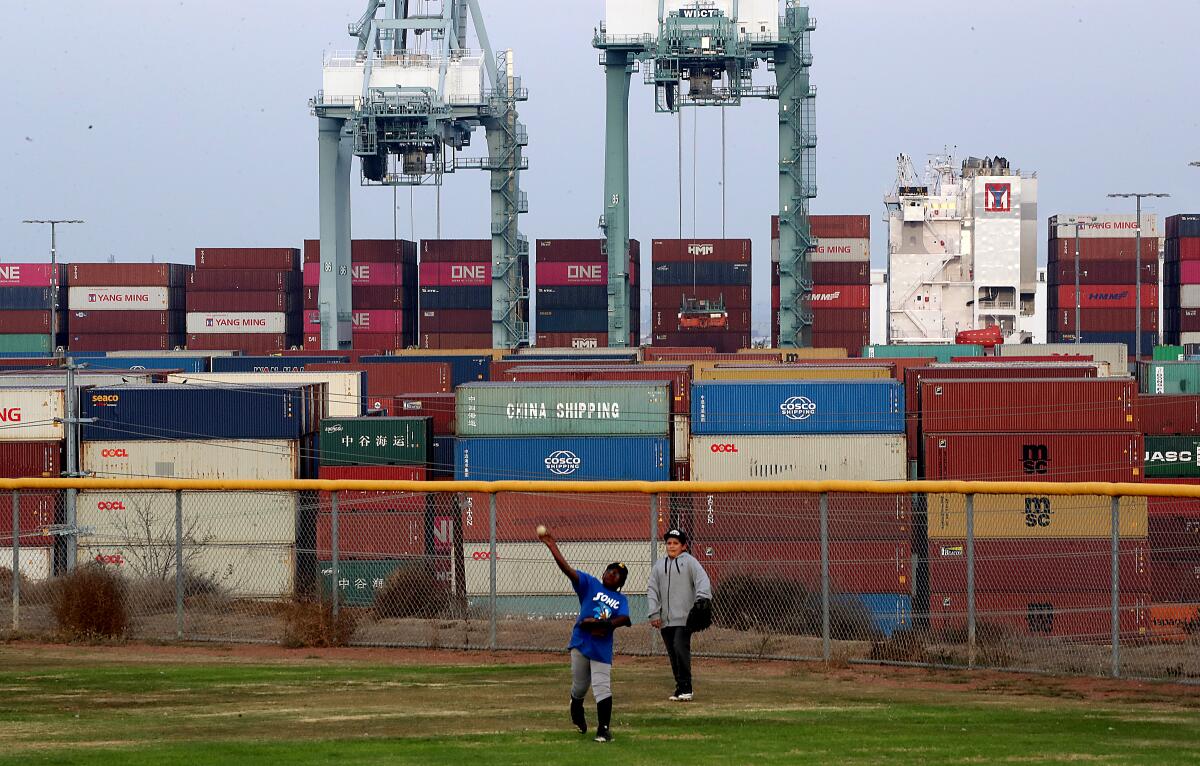Port pollution is a crisis. It’s going to take more than a $20 container fee to fix

- Share via
Dirty air is a long-standing problem at the ports of Los Angeles and Long Beach, but data released this month show just how bad things got in 2021. A pandemic-induced surge in consumer sales, record-setting volumes of cargo and a logjam of more than 100 ships anchored off the Southern California coast that fouled the air with even more harmful diesel pollution than usual. A lot more.
At the Port of L.A., cancer-causing diesel particulate matter rose 56%, smog-forming nitrogen oxides jumped 54%, and greenhouse gas emissions increased 39% compared with 2020 levels. At the Port of Long Beach, diesel particulate matter increased by 42%, nitrogen oxide emissions were up 35%, and greenhouse gases rose by 35%.
These figures should be a wake-up call to local, state and federal officials who all bear some responsibility for the failure to protect people’s health and prevent a damaging increase in smog-forming and planet-warming pollution over the past many years. This is just the latest low point in an air pollution and health crisis that demands a speedy and muscular response but has too often been met with a shrug by the officials overseeing these publicly operated ports.
The oil industry wants to put a referendum on the ballot to overturn California’s ban on neighborhood drilling. Californians shouldn’t fall for it.
The L.A.-Long Beach port complex remains Southern California’s largest single source of pollution. Neighboring communities are hit the hardest by the emissions from the ships, trucks, locomotives and cargo-handling equipment, but the ports pollute the air across Southern California, increasing smog as far away as the Inland Empire.
The recent surge in pollution came primarily from oceangoing ships. The Port of L.A. saw a staggering 147% jump in diesel particulate matter and a 136% increase in greenhouse gas emissions in 2021 over the previous year. The increase at the Long Beach port over the same time period was less dramatic, but still alarmingly high: a 71% increase in diesel particulate matter and 87% increase in greenhouse gas emissions.
Port officials have downplayed the 2021 pollution levels as a temporary uptick caused by a once-in-a-century pandemic. They have credited new congestion-reduction measures, including a new ship queuing system that began in November, with reducing emissions from ships at anchor. While air quality officials acknowledge things have improved since then, with emissions from anchored container ships “close to business-as-usual levels since January 2022,” they point out that pollution was far too high before the pandemic, and remain deeply concerned about the ongoing pollution and health impacts. Cargo volumes, after all, are still above where they were before the pandemic.
Returning to business as usual is unacceptable. The air quality in Southern California has benefited from past efforts to clean the air under the ports’ 2006 clean-air plan, but that progress can’t continue unless officials move more quickly toward a zero-emission future. Greenhouse gas emissions, in particular, are going in the wrong direction, rising 23% since 2005 at the Port of Los Angeles and 22% at the Port of Long Beach.
Five years ago L.A. Mayor Eric Garcetti and Long Beach Mayor Robert Garcia pledged to turn the ports into zero-emission operations, by 2030 for cargo-handling equipment and by 2035 for trucks. But the ports have been moving too slowly to meet these goals while resisting local air quality regulators’ efforts to hold them accountable for their clean-air pledges.
So what can be done? For starters, the South Coast Air Quality Management District should adopt long-delayed regulations to hold the port complex accountable for cleaning up its pollution, before the end of 2023. And the state Air Resources Board should accelerate its upcoming deadlines for zero-emission trucks and compel more and different classes of ships to plug into shore-side electricity while docked instead of idling their diesel engines.
The L.A. Times’ editorial board endorsements for statewide ballot measures, elected offices in Los Angeles city and county, L.A. Unified School District board, L.A. county superior court, statewide offices, the state Legislature and U.S. House and Senate seats.
In the meantime, federal officials should slash emissions from ships and locomotives, and direct a fair share of funding from the bipartisan infrastructure law and Inflation Reduction Act to Southern California projects that reduce pollution in the predominantly Latino communities near the ports that suffer some of the state’s highest asthma rates and cancer risk.
Authorities also need to put in place stronger incentives to attract the cleanest ships available to Southern California, spur the goods movement industry to speed up the adoption of zero-emission vehicles and equipment and install charging and fueling infrastructure to support them. That means doing better than the woefully inadequate $20-per-shipping-container fee the ports are now charging cargo owners to raise funds to help truckers switch from diesel engines to cleaner models. Not only is the fee far too low to make a serious difference, it should be expanded to include funding for cutting emissions from ships, cargo-handling equipment and other diesel-fueled equipment that contribute to smog and climate change.
In 2008, the California Legislature passed a $60-per-container fee on cargo moving through the ports of L.A., Long Beach and Oakland to reduce congestion and air pollution, but it was vetoed by then-Gov. Arnold Schwarzenegger. State lawmakers or city officials should revisit that idea in 2023 in light of port pollution reaching crisis levels.
The officials overseeing the ports also need to show stronger environmental leadership. This November, Los Angeles and Long Beach are electing new mayors who owe it to their constituents to take new urgent and aggressive action to slash emissions. They can show future generations that their health matters more than industry profits. These communities deserve nothing less.
More to Read
A cure for the common opinion
Get thought-provoking perspectives with our weekly newsletter.
You may occasionally receive promotional content from the Los Angeles Times.











